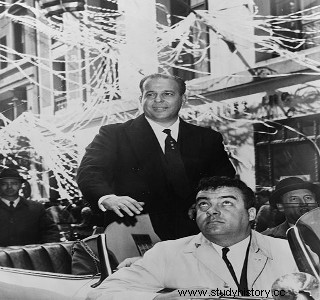
By Tales Pinto
The Wide Front was an attempt to achieve a political articulation of confrontation with the military dictatorship and of democratic opening on the part of Carlos Lacerda , Juscelino Kubitschek (JK) and João Goulart (Jango), in 1966.
Carlos Lacerda was the founder of the Frente Ampla after failing to make his successor to the post of governor of Guanabara, in 1965, and also not seeing a favorable political horizon in his intention to reach to the presidency of the Republic, with the adoption of Institutional Act nº 2 (AI-2), published in the same year, which imposed indirect elections for the position.
Lacerda was an early supporter of the coup that established the civil-military dictatorship in Brazil on March 31, 1964. But with the upsurge of the regime, he found himself removed of the military and sought an alliance with its former rivals.
Carlos Lacerda was from the National Democratic Union (UDN) and the main voice of opposition to the governments of JK and Jango. With the extinction of political parties in 1966 and the formation of the National Renewal Alliance (ARENA ) and the National Democratic Movement (MDB ), part of Lacerda's supporters joined the MDB. It was through names present in this opposition party that the military consented to, mainly Renato Ascher and Armindo Doutel de Andrade, that Lacerda tried to articulate the Frente Ampla.
However, there were several difficulties to implement it. JK and Jango were in exile, while JK was in Portugal and Jango was in Uruguay. But even so, Frente Ampla was launched in October 1966, through the publication of a manifesto addressed to the Brazilian people in the Rio de Janeiro newspaper Tribuna da Imprensa .
The demands set out in the manifesto were about free and direct elections, party and institutional reform, the resumption of economic development and the adoption of a sovereign foreign policy. It was signed only by Carlos Lacerda, but indicated the negotiation process between the three political figures.
An agreement with JK was reached a month after the publication of the manifesto and was materialized in the Declaration of Lisbon , in which the two former enemies claimed to have overcome political rivalries. Jango's negotiation and accession would take place only ten months later, in September 1967, when a joint note was signed in Montevideo, indicating that the Frente Ampla was an instrument for the restoration of public and individual freedoms.
However, with the arrival of Costa e Silva to the presidency and the intensification of repression against opponents, in addition to large demonstrations in some Brazilian cities, the Frente Ampla was officially banned on April 1968.
* Image Credit:US Library of Congress.
